MAZDA 6 2002 Workshop Manual Suplement
Manufacturer: MAZDA, Model Year: 2002, Model line: 6, Model: MAZDA 6 2002Pages: 909, PDF Size: 17.16 MB
Page 641 of 909

ELECTRONIC 4WD CONTROL SYSTEM
M–11
M
4WD solenoid control current is ON
•When the 4WD solenoid control current is ON, current flows from the 4WD CM to the 4WD solenoid, and the
coupling operates in the following manner.
1. Magnetic flux forms at the electromagnetic coil of the 4WD solenoid.
2. Due to the magnetic flux in the armature, the pilot clutch is suctioned towards the magnetic coil side and
made to engage. This causes frictional torque to generate in the pilot clutch.
3. The torque is transmitted to the pilot cam, which is engaged with the pilot clutch.
4. A rotational difference is created between the pilot cam and the main cam. Due to this relative torsion, the
cam mechanism operates, transmitting torque from the pilot cam to the ball and then to the main cam. In
this way, the push force exerted on the main clutch is amplified.
5. As the main clutch engages, the drive torque from the front wheels is transmitted to the rear wheels.
•The amount of push force exerted on the main clutch by the main cam (that is, the strength of the drive torque
transmitted to the rear wheels) changes in accordance with the proportion of the force acting upon the pilot
cam, engaged with the pilot clutch. Therefore, by changing the periodicity of the electric current from the 4WD
CM to the 4WD solenoid (ON/OFF rate of the 4WD solenoid = force acting on the pilot cam), the module
controls the transmission of drive torque to the rear wheels.
.
End Of Sie
98
75
4
3
10
11
6
12
56
7
12
A6E63222005
1 Main clutch
2Pilot clutch
3 4WD solenoid (Electromagnetic coil)
4 4WD control modure (4WD CM)
5Main cam
6Pilot cam7Ball
8Armature
9 Drive torque
10 Magnetic flux
11 Input
12 Output
Page 642 of 909
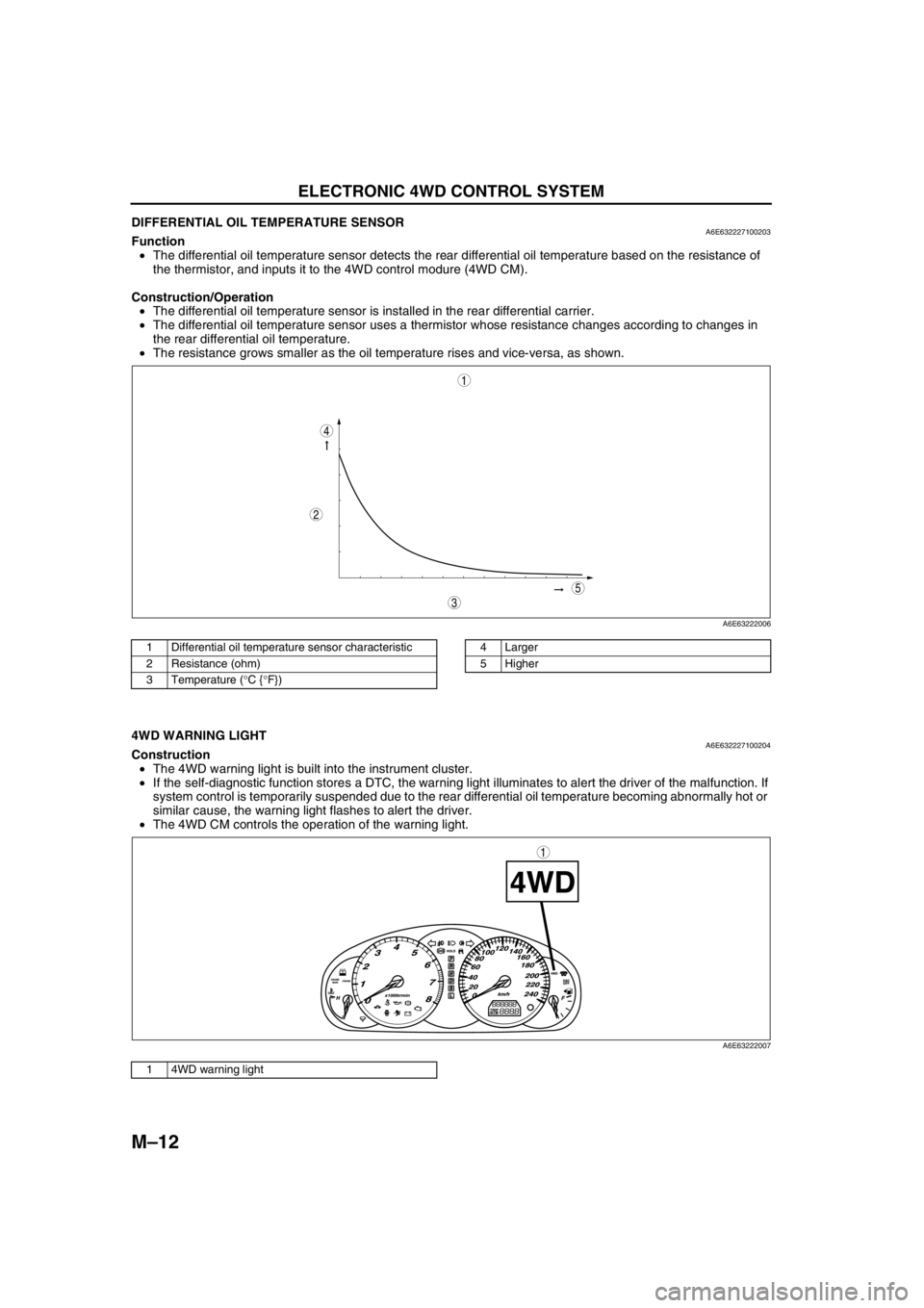
M–12
ELECTRONIC 4WD CONTROL SYSTEM
DIFFERENTIAL OIL TEMPERATURE SENSORA6E632227100203Function
•The differential oil temperature sensor detects the rear differential oil temperature based on the resistance of
the thermistor, and inputs it to the 4WD control modure (4WD CM).
Construction/Operation
•The differential oil temperature sensor is installed in the rear differential carrier.
•The differential oil temperature sensor uses a thermistor whose resistance changes according to changes in
the rear differential oil temperature.
•The resistance grows smaller as the oil temperature rises and vice-versa, as shown.
.
End Of Sie
4WD WARNING LIGHTA6E632227100204Construction
•The 4WD warning light is built into the instrument cluster.
•If the self-diagnostic function stores a DTC, the warning light illuminates to alert the driver of the malfunction. If
system control is temporarily suspended due to the rear differential oil temperature becoming abnormally hot or
similar cause, the warning light flashes to alert the driver.
•The 4WD CM controls the operation of the warning light.
.
End Of Sie
5
4
3
1
2
A6E63222006
1 Differential oil temperature sensor characteristic
2 Resistance (ohm)
3 Temperature (°C {°F})4 Larger
5 Higher
1
A6E63222007
1 4WD warning light
Page 643 of 909
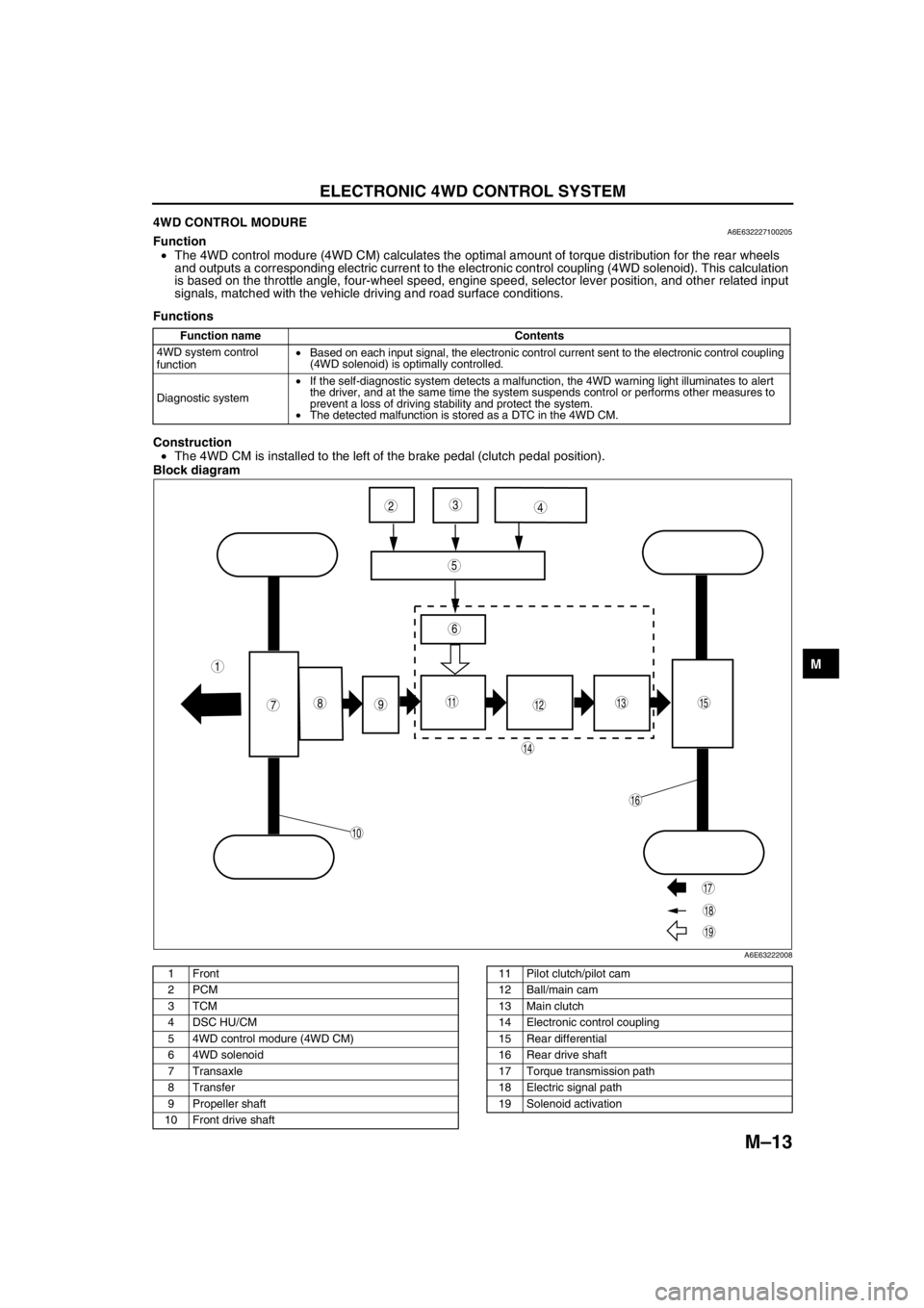
ELECTRONIC 4WD CONTROL SYSTEM
M–13
M
4WD CONTROL MODUREA6E632227100205Function
•The 4WD control modure (4WD CM) calculates the optimal amount of torque distribution for the rear wheels
and outputs a corresponding electric current to the electronic control coupling (4WD solenoid). This calculation
is based on the throttle angle, four-wheel speed, engine speed, selector lever position, and other related input
signals, matched with the vehicle driving and road surface conditions.
Functions
Construction
•The 4WD CM is installed to the left of the brake pedal (clutch pedal position).
Block diagram
.
Function name Contents
4WD system control
function•Based on each input signal, the electronic control current sent to the electronic control coupling
(4WD solenoid) is optimally controlled.
Diagnostic system•If the self-diagnostic system detects a malfunction, the 4WD warning light illuminates to alert
the driver, and at the same time the system suspends control or performs other measures to
prevent a loss of driving stability and protect the system.
•The detected malfunction is stored as a DTC in the 4WD CM.
987
5
43
10
19
18
17
15
16
14
131112
6
1
2
A6E63222008
1Front
2PCM
3TCM
4 DSC HU/CM
5 4WD control modure (4WD CM)
6 4WD solenoid
7Transaxle
8Transfer
9 Propeller shaft
10 Front drive shaft11 Pilot clutch/pilot cam
12 Ball/main cam
13 Main clutch
14 Electronic control coupling
15 Rear differential
16 Rear drive shaft
17 Torque transmission path
18 Electric signal path
19 Solenoid activation
Page 644 of 909
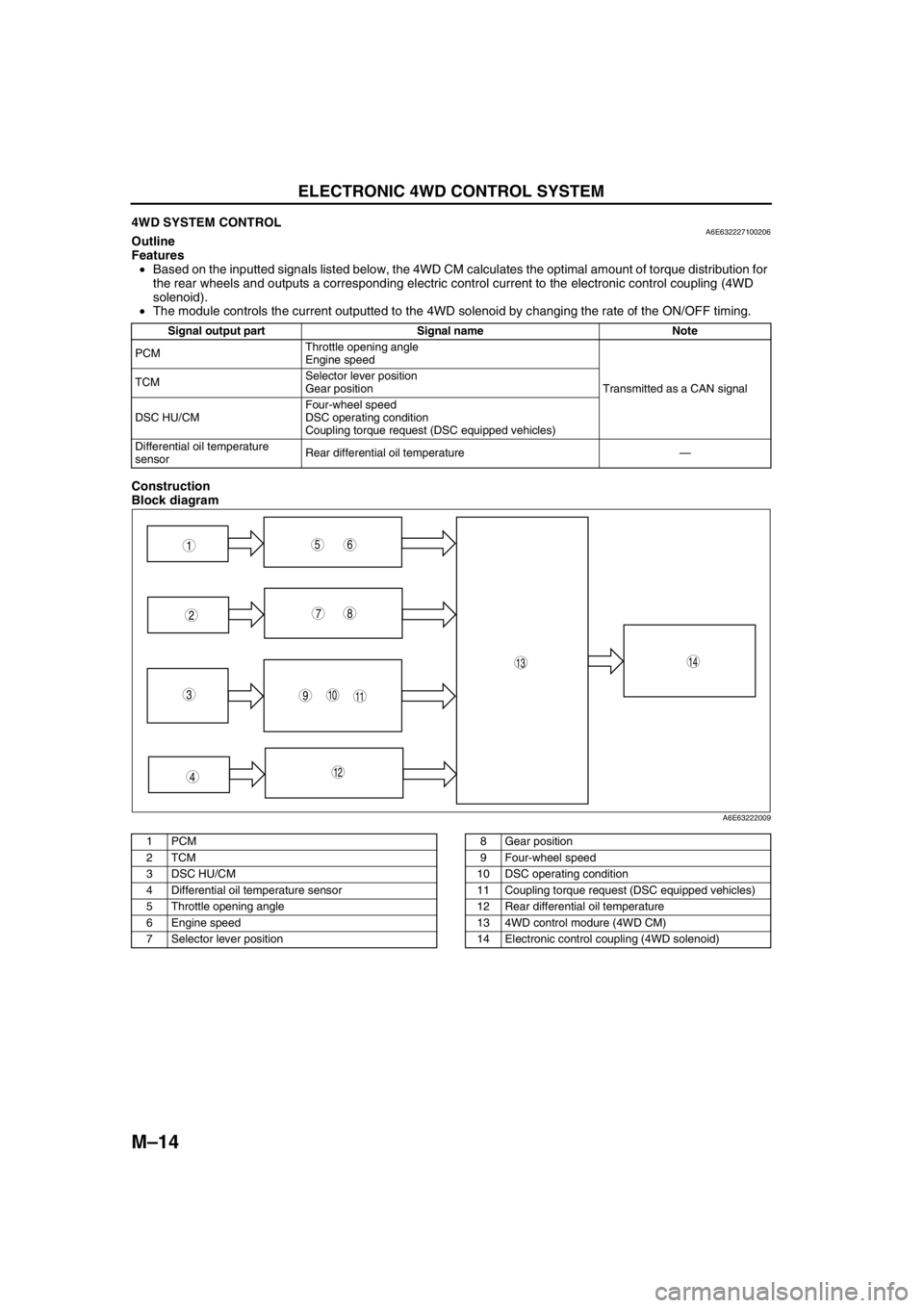
M–14
ELECTRONIC 4WD CONTROL SYSTEM
End Of Sie4WD SYSTEM CONTROLA6E632227100206Outline
Features
•Based on the inputted signals listed below, the 4WD CM calculates the optimal amount of torque distribution for
the rear wheels and outputs a corresponding electric control current to the electronic control coupling (4WD
solenoid).
•The module controls the current outputted to the 4WD solenoid by changing the rate of the ON/OFF timing.
Construction
Block diagram
.
Signal output part Signal name Note
PCMThrottle opening angle
Engine speed
Transmitted as a CAN signal TCMSelector lever position
Gear position
DSC HU/CMFour-wheel speed
DSC operating condition
Coupling torque request (DSC equipped vehicles)
Differential oil temperature
sensorRear differential oil temperature—
9
87
5
4
310
1413
11
12
61
2
A6E63222009
1PCM
2TCM
3 DSC HU/CM
4 Differential oil temperature sensor
5 Throttle opening angle
6 Engine speed
7 Selector lever position8 Gear position
9 Four-wheel speed
10 DSC operating condition
11 Coupling torque request (DSC equipped vehicles)
12 Rear differential oil temperature
13 4WD control modure (4WD CM)
14 Electronic control coupling (4WD solenoid)
Page 645 of 909
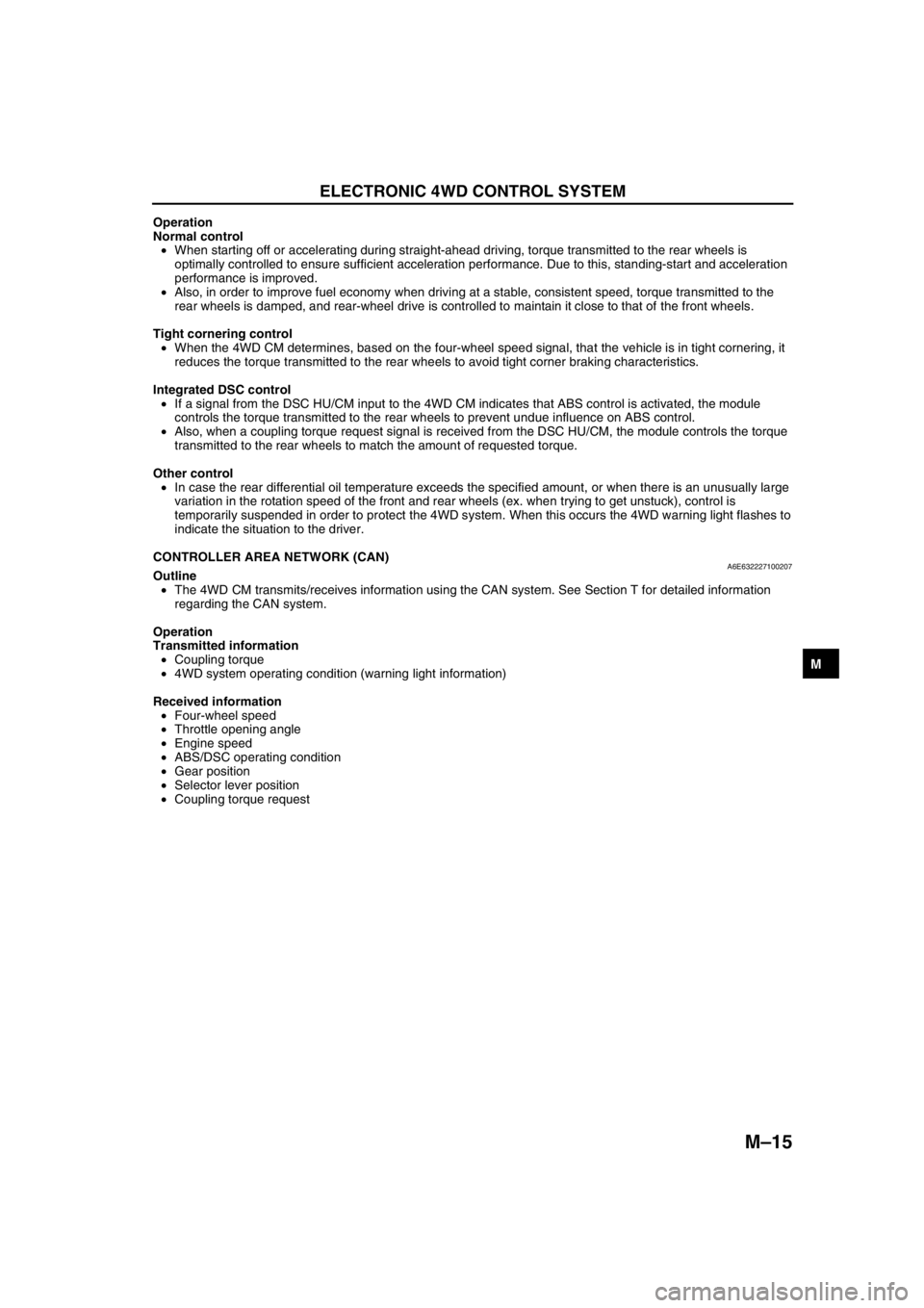
ELECTRONIC 4WD CONTROL SYSTEM
M–15
M
Operation
Normal control
•When starting off or accelerating during straight-ahead driving, torque transmitted to the rear wheels is
optimally controlled to ensure sufficient acceleration performance. Due to this, standing-start and acceleration
performance is improved.
•Also, in order to improve fuel economy when driving at a stable, consistent speed, torque transmitted to the
rear wheels is damped, and rear-wheel drive is controlled to maintain it close to that of the front wheels.
Tight cornering control
•When the 4WD CM determines, based on the four-wheel speed signal, that the vehicle is in tight cornering, it
reduces the torque transmitted to the rear wheels to avoid tight corner braking characteristics.
Integrated DSC control
•If a signal from the DSC HU/CM input to the 4WD CM indicates that ABS control is activated, the module
controls the torque transmitted to the rear wheels to prevent undue influence on ABS control.
•Also, when a coupling torque request signal is received from the DSC HU/CM, the module controls the torque
transmitted to the rear wheels to match the amount of requested torque.
Other control
•In case the rear differential oil temperature exceeds the specified amount, or when there is an unusually large
variation in the rotation speed of the front and rear wheels (ex. when trying to get unstuck), control is
temporarily suspended in order to protect the 4WD system. When this occurs the 4WD warning light flashes to
indicate the situation to the driver.
End Of Sie
CONTROLLER AREA NETWORK (CAN)A6E632227100207Outline
•The 4WD CM transmits/receives information using the CAN system. See Section T for detailed information
regarding the CAN system.
Operation
Transmitted information
•Coupling torque
•4WD system operating condition (warning light information)
Received information
•Four-wheel speed
•Throttle opening angle
•Engine speed
•ABS/DSC operating condition
•Gear position
•Selector lever position
•Coupling torque request
End Of Sie
Page 646 of 909
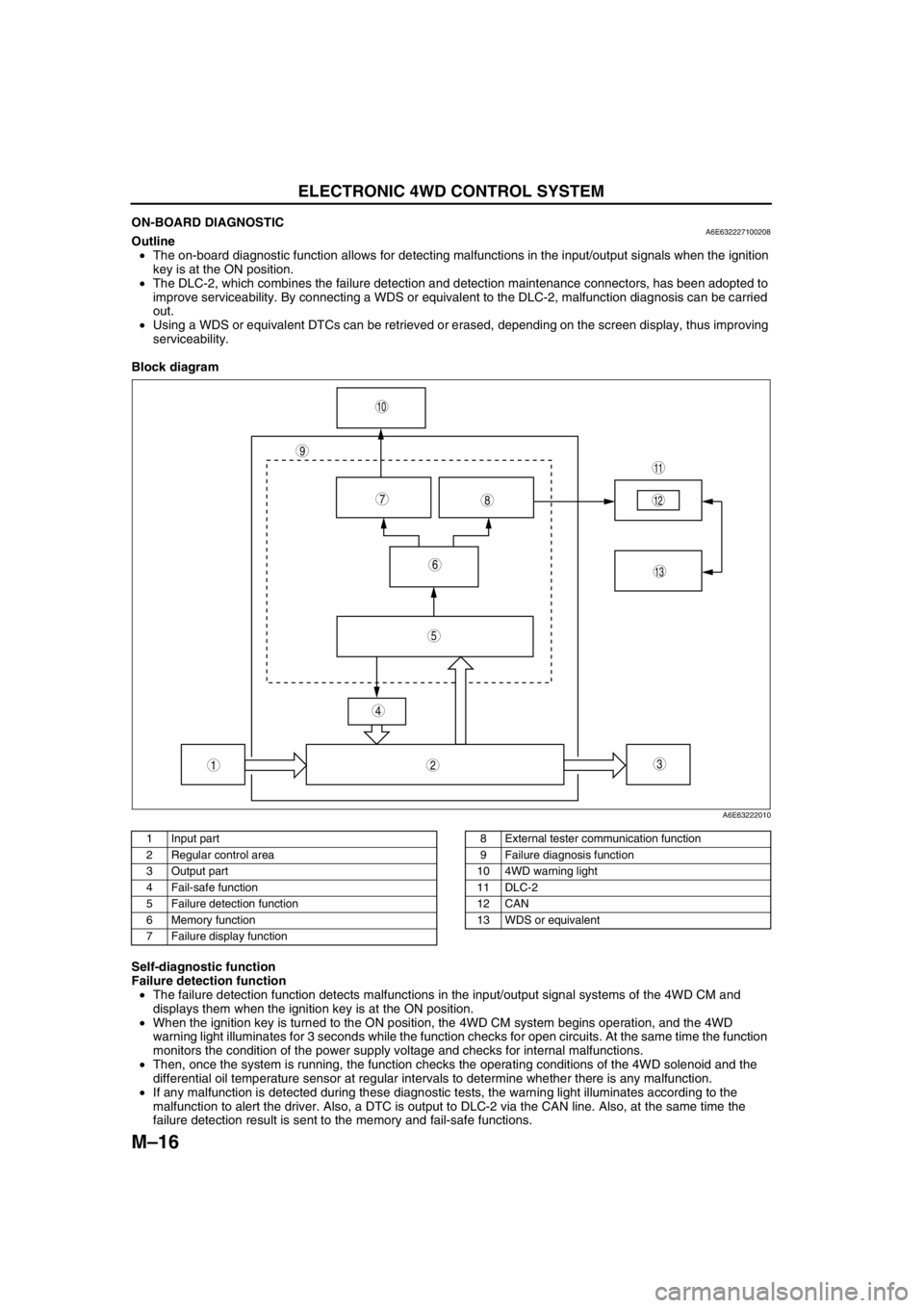
M–16
ELECTRONIC 4WD CONTROL SYSTEM
ON-BOARD DIAGNOSTICA6E632227100208Outline
•The on-board diagnostic function allows for detecting malfunctions in the input/output signals when the ignition
key is at the ON position.
•The DLC-2, which combines the failure detection and detection maintenance connectors, has been adopted to
improve serviceability. By connecting a WDS or equivalent to the DLC-2, malfunction diagnosis can be carried
out.
•Using a WDS or equivalent DTCs can be retrieved or erased, depending on the screen display, thus improving
serviceability.
Block diagram
.
Self-diagnostic function
Failure detection function
•The failure detection function detects malfunctions in the input/output signal systems of the 4WD CM and
displays them when the ignition key is at the ON position.
•When the ignition key is turned to the ON position, the 4WD CM system begins operation, and the 4WD
warning light illuminates for 3 seconds while the function checks for open circuits. At the same time the function
monitors the condition of the power supply voltage and checks for internal malfunctions.
•Then, once the system is running, the function checks the operating conditions of the 4WD solenoid and the
differential oil temperature sensor at regular intervals to determine whether there is any malfunction.
•If any malfunction is detected during these diagnostic tests, the warning light illuminates according to the
malfunction to alert the driver. Also, a DTC is output to DLC-2 via the CAN line. Also, at the same time the
failure detection result is sent to the memory and fail-safe functions.
9
87
5
4
3
10
13
11
12
6
12
A6E63222010
1 Input part
2 Regular control area
3 Output part
4 Fail-safe function
5 Failure detection function
6 Memory function
7 Failure display function8 External tester communication function
9 Failure diagnosis function
10 4WD warning light
11 DLC-2
12 CAN
13 WDS or equivalent
Page 647 of 909
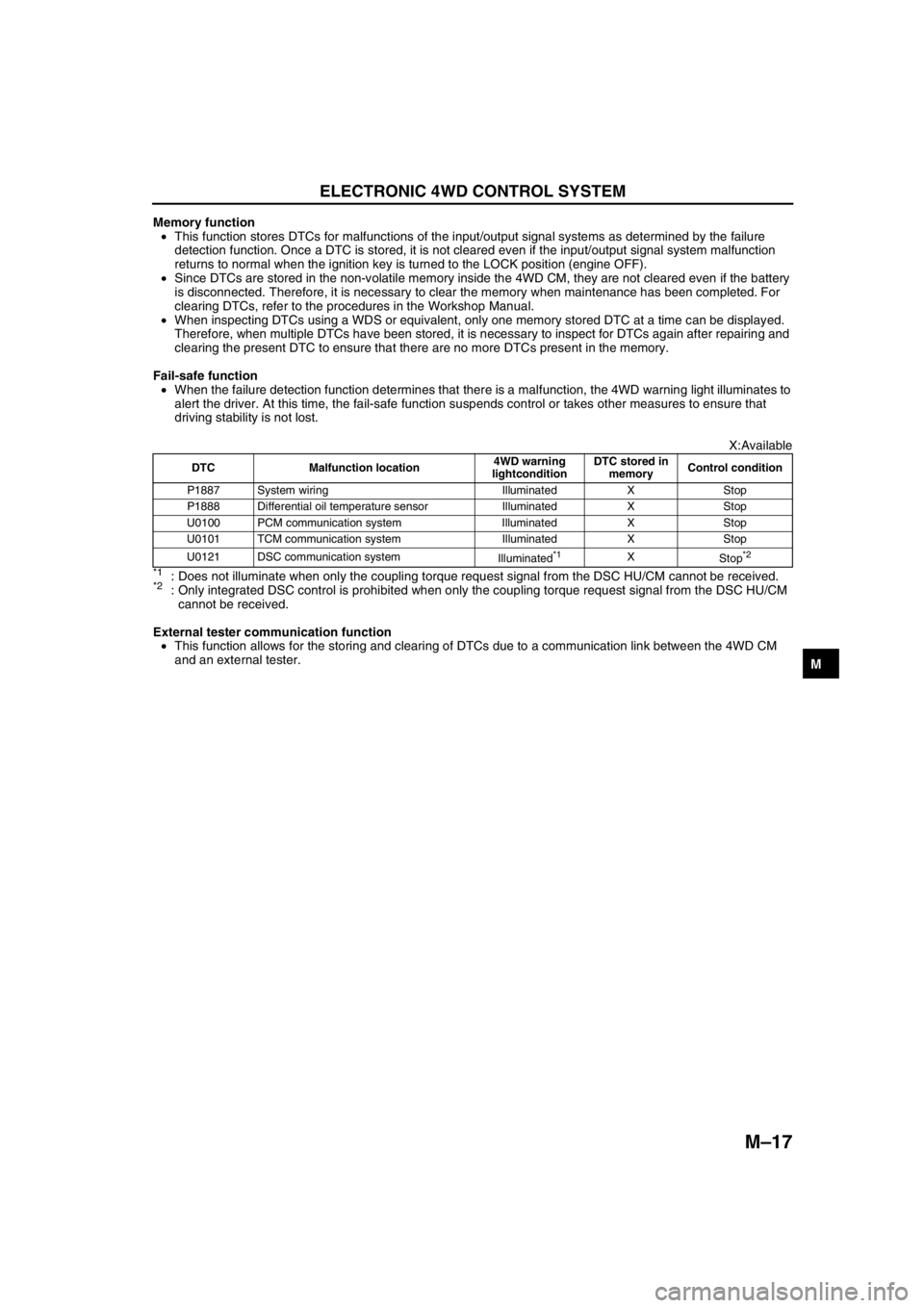
ELECTRONIC 4WD CONTROL SYSTEM
M–17
M
Memory function
•This function stores DTCs for malfunctions of the input/output signal systems as determined by the failure
detection function. Once a DTC is stored, it is not cleared even if the input/output signal system malfunction
returns to normal when the ignition key is turned to the LOCK position (engine OFF).
•Since DTCs are stored in the non-volatile memory inside the 4WD CM, they are not cleared even if the battery
is disconnected. Therefore, it is necessary to clear the memory when maintenance has been completed. For
clearing DTCs, refer to the procedures in the Workshop Manual.
•When inspecting DTCs using a WDS or equivalent, only one memory stored DTC at a time can be displayed.
Therefore, when multiple DTCs have been stored, it is necessary to inspect for DTCs again after repairing and
clearing the present DTC to ensure that there are no more DTCs present in the memory.
Fail-safe function
•When the failure detection function determines that there is a malfunction, the 4WD warning light illuminates to
alert the driver. At this time, the fail-safe function suspends control or takes other measures to ensure that
driving stability is not lost.
X:Available
*1: Does not illuminate when only the coupling torque request signal from the DSC HU/CM cannot be received.*2: Only integrated DSC control is prohibited when only the coupling torque request signal from the DSC HU/CM
cannot be received.
External tester communication function
•This function allows for the storing and clearing of DTCs due to a communication link between the 4WD CM
and an external tester.
End Of Sie
DTC Malfunction location4WD warning
lightconditionDTC stored in
memoryControl condition
P1887 System wiring Illuminated X Stop
P1888 Differential oil temperature sensor Illuminated X Stop
U0100 PCM communication system Illuminated X Stop
U0101 TCM communication system Illuminated X Stop
U0121 DSC communication system
Illuminated
*1X
Stop*2
Page 648 of 909

M–18
OUTLINE
SUPPLEMENTAL SERVICE INFORMATIONA6E630201018204•The following additions have been made since publication of the Mazda6 Workshop Manual (1730-1*-02C).
Rear wheel hub bolt
•Replacement procedure has been added.
Wheel hub, knuckle
•Removal/installation procedure has been added.
Joint shaft (MZR-CD (RF Turbo))
•Disassembly/assembly procedure has been added.
Joint shaft (4WD)
•Disassembly/assembly procedure has been added.
Front drive shaft (MZR-CD (RF Turbo))
•Disassembly/assembly procedure has been added.
Front drive shaft (4WD)
•Disassembly/assembly procedure has been added.
Rear drive shaft
•Inspection procedure has been added.
•Removal/installation procedure has been added.
•Disassembly/assembly procedure has been added.
Differential oil
•Inspection procedure has been added.
•Replacement procedure has been added.
Oil seal (side gear)
•Replacement procedure has been added.
Oil seal (companion flange)
•Replacement procedure has been added.
Rear differential
•Removal/installation procedure has been added.
•Disassembly procedure has been added.
•Assembly procedure has been added.
Differential oil temperature sensor
•Inspection procedure has been added.
•Removal/installation procedure has been added.
4WD solenoid
•Inspection procedure has been added.
Coupling component
•Removal/installation procedure has been added.
•Disassembly procedure has been added.
•Assembly procedure has been added.
On-board diagnostic
•Electronic 4WD control system have been added.
Troubleshooting
•Electronic 4WD control system have been added.
End Of Sie
OUTLINE
Page 649 of 909

LOCATION INDEX
M–19
M
AXLE/DRIVE SHAFT LOCATION INDEXA6E630025500201
.
End Of Sie
LOCATION INDEX
5
4
3
1
2
A6J63002001
1 Wheel hub bolt
(See M–22 WHEEL HUB BOLT REPLACEMENT)
2 Wheel hub, knuckle
(See M–22 WHEEL HUB, KNUCKLE REMOVAL/
INSTALLATION)
3 Joint shaft
(See M–29 JOINT SHAFT (MZR-CD (RF Turbo))
DISASSEMBLY/ASSEMBLY)
(See M–31 JOINT SHAFT (4WD) DISASSEMBLY/
ASSEMBLY)4 Front drive shaft
(See M–34 FRONT DRIVE SHAFT (MZR-CD (RF
Turbo)) DISASSEMBLY/ASSEMBLY)
(See M–39 FRONT DRIVE SHAFT (4WD)
DISASSEMBLY/ASSEMBLY)
5 Rear drive shaft
(See M–42 REAR DRIVE SHAFT
PRE-INSPECTION)
(See M–43 REAR DRIVE SHAFT REMOVAL/
INSTALLATION)
(See M–45 REAR DRIVE SHAFT DISASSEMBLY/
ASSEMBLY)
Page 650 of 909

M–20
LOCATION INDEX
REAR DIFFERENTIAL/ELECTRONIC 4WD CONTROL SYSTEM LOCATION INDEXA6E630027100201
.
End Of Sie
8
7
5
4
3
6
1
2
8
7
5
4
3
6
1
2
L.H.D.
R.H.D.
A6J63002002
1 Differential oil
(See M–48 DIFFERENTIAL OIL INSPECTION)
(See M–48 DIFFERENTIAL OIL REPLACEMENT)
2 Oil seal (side gear)
(See M–49 OIL SEAL (SIDE GEAR)
REPLACEMENT)
3 Oil seal (companion flange)
(See M–49 OIL SEAL (COMPANION FLANGE)
REPLACEMENT)
4 Rear differential
(See M–51 REAR DIFFERENTIAL REMOVAL/
INSTALLATION)
(See M–52 REAR DIFFERENTIAL DISASSEMBLY)
(See M–56 REAR DIFFERENTIAL ASSEMBLY)5 Differential oil temperature sensor
(See M–65 DIFFERENTIAL OIL TEMPERATURE
SENSOR INSPECTION)
(See M–65 DIFFERENTIAL OIL TEMPERATURE
SENSOR REMOVAL/INSTALLATION)
6 4WD solenoid
(See M–66 4WD SOLENOID INSPECTION)
7 4WD control module
(See M–66 4WD CONTROL MODURE
INSPECTION)
(See M–67 4WD CONTROL MODURE REMOVAL/
INSTALLATION)
8 Coupling component
(See M–68 COUPLING COMPONENT REMOVAL/
INSTALLATION)
(See M–69 COUPLING COMPONENT
DISASSEMBLY)
(See M–72 COUPLING COMPONENT
ASSEMBLY)